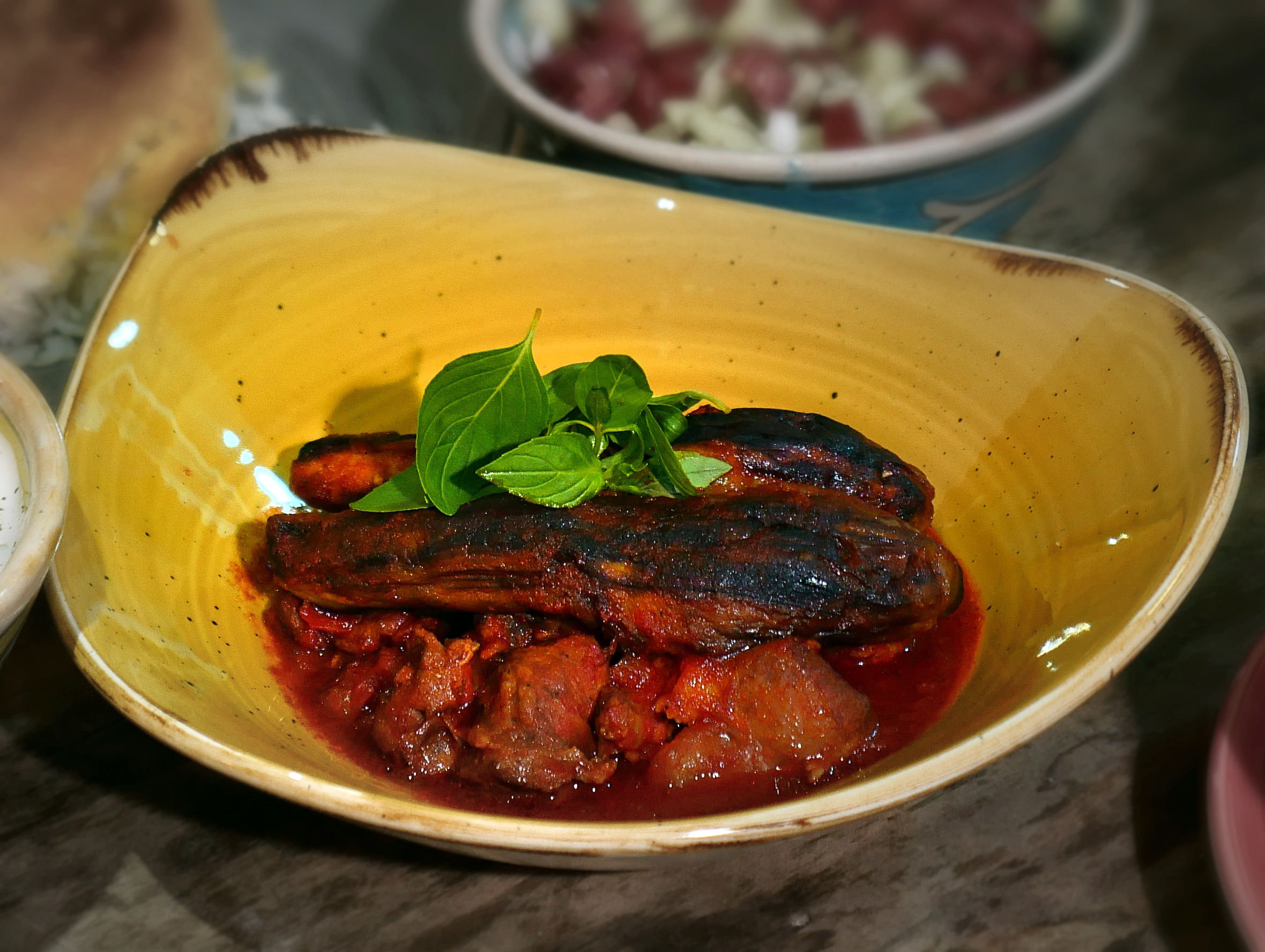Chef Bahar Sarhangi’s Khoresht-e Bademjan Recipe

During Conflict Kitchen’s Iranian Virtual Cooking Lesson participants prepared two dishes under the instruction of Chef Bahar Sarhangi: Khoresht-e Bademjan (Eggplant Stew) and Tahdig (Crispy Iranian Rice.) The recipes for both are included below.
Notes on preparation and serving:
- You can easily use any cut of lamb or chicken in place of lamb shoulder. You can make a vegetarian adaptation by omitting meat. If you make a vegetarian version, you may want to add an extra pound of eggplant in place of meat.
- Eggplants in Iran are smaller and much thinner than a typical American eggplant, but any shape of eggplant will work in this recipe.
- Verjuice is a very acidic juice made from unripe grapes. If you can’t find it, you can substitute red wine, pomegranate juice, wine vinegar and lemon juice.
- Tahdig means “the bottom of the pan” in Farsi. It is a crispy, disk-shaped saffron rice dish. It’s stunning and delicious, but it requires some patience to perfect. To ensure that your tahdig comes out in one piece with a crispy top layer, you can add a piece of flatbread to the bottom of the plan. If saffron is too expensive, you can substitute turmeric to give your tahdig a similar color. You can also serve the khoresht with plain rice instead of tahdig.
- In Iran, khoreshts (stews) are traditionally served with a number of different mokhalafat (accompaniments) including sabzi (fresh herbs), sliced cucumber and tomatoes, mast-o (yogurt) and torshi (pickles). You may want to serve your stew with a handful of mokhalafat to round out your meal.
Ingredients:
1.5 lbs lamb shoulder, cut into 1 inch pieces
2.75 lbs eggplant
2 medium white onions, sliced
4 medium tomatoes, peeled, cored and quartered
½ cup tomato paste
¼ cup + 1 tsp salt
1 tsp pepper
1 tsp cinnamon
1 bay leaf
1 cup vegetable oil or ghee
¼ cup verjuice
2 cups basmati rice
4 tbsp butter or ghee
½ tsp saffron
¼ tsp salt
Make the Khoresht-e Bademjan:
- Peel the eggplant. If using an large, round eggplant, quarter it. Mix ¼ cup salt into 2 cups water. Allow eggplant to soak in water for 20 minutes. Drain and at dry.
- Over medium heat, heat 3/4 cup oil in a sauté pan. Sear both sides of the eggplant until golden brown and crispy on the outside. The eggplants should be mostly cooked before removing them from the oil, about 10 minutes depending on their thickness. Set aside on a towel to soak up the extra oil.
- In a large pot or dutch oven, heat the rest of the oil over medium-high heat. Sear meat until color begins to develop.
- Turn down the heat to medium and add sliced onions. Stir continuously as the onions begin to caramelize, about 15 minutes.
- Add tomato paste, tomatoes, a teaspoon of salt, cinnamon and one cup of water. When the tomatoes begin to break down, stir in the verjuice.
- Simmer the stew for about an hour, until protein is tender. As the stew simmers, prepare the Tahdig.
- Just before serving, mix in the eggplant. Allow the eggplant to heat up and serve over rice.
Tahdig:
- Parcook the rice: simmer 4 cups water and 2 cups rice for about 10 minutes. When the outside of the grain is soft but the center is not fully cooked, drain the rice.
- In a wide nonstick pot, melt butter over medium heat. Add saffron and allow it to steep in butter for a minute. Add the rice and ½ cup water. Sprinkle salt on top. Place lid on pot and allow rice to cook until the bottom is golden and crispy, about 30 minutes. If necessary, turn up the heat in the last five minutes of cooking to better crisp the rice in the bottom of the plan.
- Flip the rice over onto a plate. It should come out in one golden disk-shaped piece.
